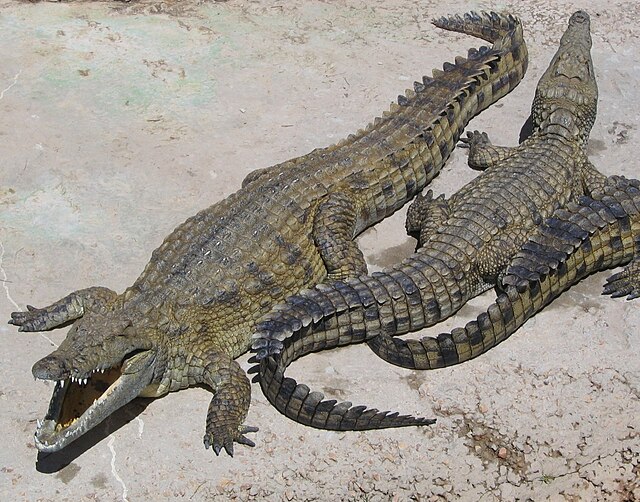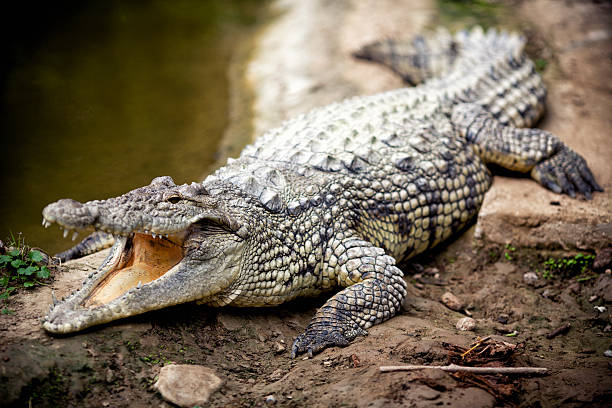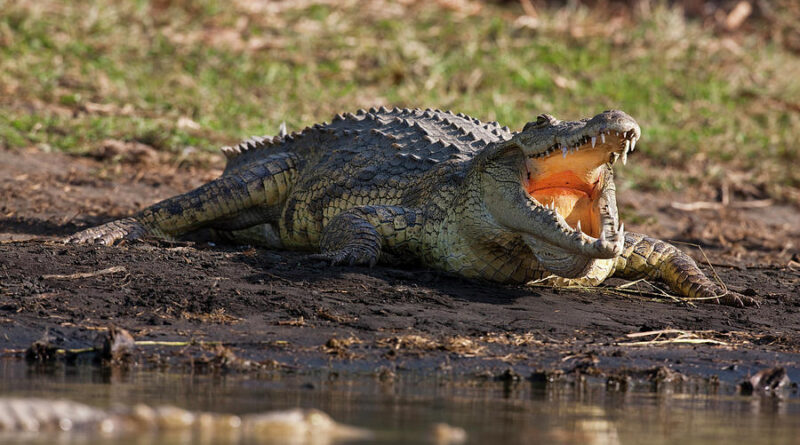Nile Crocodile Nocturnal Activity
Introduction
Nile Crocodile Nocturnal Activity The Nile crocodile (Crocodylus niloticus), one of the largest and most formidable reptiles in the world, is renowned for its stealth and power. Predominantly found across sub-Saharan Africa, these apex predators are often associated with daylight basking and ambushing prey along riverbanks. However, a significant portion of their life remains shrouded in mystery—particularly their nocturnal behavior. This article delves into the less-explored aspect of Nile crocodile nocturnal activity, shedding light on their nighttime habits, ecological impact, and interactions within their environment.
Habitat and Distribution

Nile crocodiles are primarily found in freshwater habitats, such as rivers, lakes, and marshlands, though they can occasionally inhabit brackish water areas. Their distribution spans most of sub-Saharan Africa, including the Nile Basin, parts of West Africa, and even isolated populations in Madagascar. These versatile habitats provide ample cover and opportunities for nighttime activities, from feeding to defending territories.
Sure! Here’s a table summarizing key aspects of Nile crocodile nocturnal activity:
| Aspect | Description |
|---|---|
| Nocturnal Adaptations | – Enhanced night vision due to the tapetum lucidum layer in the eyes. |
| – Acute hearing and pressure-sensitive sensory organs (ISOs) for detecting vibrations. | |
| – Behavioral shift to increased mobility and hunting activity at night. | |
| Types of Nocturnal Activities | Hunting and Feeding: Utilizes stealth to ambush prey such as fish and mammals. Success rate is higher at night. |
| Territorial Behavior: Males patrol territories and engage in vocalizations and displays to assert dominance. | |
| Reproductive Behavior: Nighttime courtship involves vocalizations and physical contact. | |
| Resting and Thermoregulation: Selects warmer spots to maintain body temperature during cooler night conditions. | |
| Impact on Ecosystem | – Helps regulate prey populations, preventing overgrazing of aquatic vegetation. |
| – Affects behavior of other species, leading to temporal partitioning and habitat use shifts. | |
| Human Interaction and Threats | – Nighttime activities increase risk of human-crocodile encounters, leading to potential conflict and safety risks. |
| – Artificial lighting and habitat disruption can alter natural nocturnal behaviors. | |
| Research and Observation | – Use of GPS and radio tracking, night vision cameras, and acoustic monitoring. |
| – Challenges include high costs, equipment failure, and accessibility of habitats. | |
| Conservation Implications | – Protection of nocturnal habitats and minimizing human disturbance are key strategies. |
| – Community education on nocturnal safety in crocodile habitats can reduce human-crocodile conflicts. |
This table can be used to provide a quick overview of the main points discussed in the article on Nile crocodile nocturnal activity.
During the day, Nile crocodiles often bask in the sun to regulate their body temperature. As the sun sets and temperatures drop, they become increasingly active. Understanding how their habitat influences these nocturnal activities is crucial, as it determines prey availability, thermoregulation strategies, and interaction with other species.
Nocturnal Adaptations

Nile crocodiles are equipped with several adaptations that make them effective nocturnal hunters. One of the most notable is the presence of a specialized layer in their eyes known as the tapetum lucidum. This reflective structure enhances their night vision, allowing them to detect prey even in low-light conditions. When illuminated by light, their eyes exhibit a characteristic glow, similar to that of cats and other nocturnal predators.
In addition to enhanced vision, Nile crocodiles rely on acute hearing and an array of sensory organs, known as integumentary sensory organs (ISOs), scattered across their skin. These sensory pits detect changes in water pressure and vibrations, enabling them to locate prey and navigate their environment with precision.
Behaviorally, Nile crocodiles exhibit a shift in activity patterns between day and night. While they remain relatively sedentary during daylight hours, conserving energy and avoiding heat stress, they become more mobile and exploratory at night.
Types of Nocturnal Activities
Nile crocodiles engage in a variety of activities at night, each serving distinct ecological and biological purposes:
- Hunting and Feeding:
Nighttime provides a strategic advantage for hunting. The reduced visibility makes it easier for crocodiles to approach unsuspecting prey, such as fish, birds, and small mammals, without being detected. Crocodiles often employ a stealth-based approach, gliding silently through the water before launching a sudden attack. Studies suggest that nocturnal hunting yields higher success rates compared to daytime hunts, as prey are less alert and the element of surprise is in favor of the crocodile. - Territorial Behavior:
Adult Nile crocodiles are highly territorial, especially during the breeding season. At night, they patrol their territories to ward off potential rivals and intruders. Male crocodiles may engage in low-frequency vocalizations and display aggressive behaviors, such as head slapping and tail swishing, to establish dominance. - Reproductive Behavior:
Although courtship and mating can occur during the day, these activities are often initiated at night. Male crocodiles produce deep, resonant bellows that travel long distances underwater, attracting females and deterring other males. Once a female is receptive, the pair engages in a complex courtship ritual involving synchronized swimming and physical contact. - Resting and Thermoregulation:
Even at night, thermoregulation remains a critical aspect of a crocodile’s life. In cooler regions, they may bask in residual heat from sun-warmed surfaces or remain submerged in warmer waters. Crocodiles often select resting spots with easy access to water, allowing them to quickly retreat if disturbed.
5. Impact of Nocturnal Activity on Ecosystem

Nile crocodiles play a pivotal role in maintaining the ecological balance of their habitats. Their nocturnal activities, particularly hunting, help regulate prey populations such as fish, amphibians, and even smaller mammals. By controlling these populations, crocodiles prevent overgrazing of aquatic vegetation and ensure a healthy balance of species within their ecosystems.
Their presence also influences the behavior of other nocturnal and diurnal species. For example, the threat of crocodile predation may deter certain animals from using water sources at night, leading to temporal partitioning of habitats. This, in turn, affects the distribution and activity patterns of other species, contributing to the dynamic complexity of these ecosystems.
Human Interaction and Nocturnal Threats
The nocturnal activities of Nile crocodiles often bring them into conflict with human populations living near water bodies. Nighttime fishing, swimming, and boating can inadvertently lead to encounters, which may result in fatal attacks. Such interactions pose risks not only to humans but also to crocodiles, as they are sometimes targeted for retaliatory killing or captured for relocation.
Artificial lighting from urban expansion and tourism can also disrupt the natural behavior of these reptiles. Exposure to unnatural light sources may cause disorientation, altered hunting patterns, and increased stress, potentially impacting their health and reproductive success.
Research and Observation Methods

Studying nocturnal behavior in Nile crocodiles presents unique challenges. Traditional methods such as visual observation are limited by low visibility and the crocodile’s elusive nature. As a result, researchers employ various technologies, including:
- GPS and Radio Tracking: Attaching transmitters to individuals allows scientists to monitor movements, habitat use, and activity patterns remotely.
- Night Vision Cameras and Infrared Imaging: These tools provide real-time visuals of crocodiles’ nighttime activities without disturbing their natural behavior.
- Acoustic Monitoring: Hydrophones are used to detect vocalizations and movement underwater, offering insights into communication and interaction.
Despite these advancements, there are still limitations. Equipment failures, high costs, and difficulties in accessing certain habitats hinder comprehensive studies of nocturnal behavior.
Conservation Implications
Understanding the nocturnal behavior of Nile crocodiles is essential for effective conservation management. Habitat preservation efforts must consider the full spectrum of crocodile activities, both day and night. Protecting key nocturnal hunting grounds and minimizing human disturbance during these hours can reduce conflict and enhance crocodile populations.

Conservation strategies should also focus on educating local communities about the risks associated with nighttime activities in crocodile habitats. Promoting coexistence and implementing safety measures, such as controlled lighting and designated swimming areas, can help mitigate human-crocodile conflicts.
Conclusion
Nile crocodiles are formidable predators whose nocturnal behavior significantly influences the ecosystems they inhabit. From hunting and feeding to territorial patrolling and reproductive activities, their nighttime habits play a crucial role in maintaining ecological balance. Understanding these behaviors not only enriches our knowledge of this iconic species but also informs better conservation strategies to ensure their continued survival. Future research should focus on filling knowledge gaps and exploring the intricate connections between Nile crocodiles and their nighttime world.
Tips for Safely Coexisting with Nile Crocodiles During Nighttime
Avoid Water Activities After Dusk:
Refrain from swimming, fishing, or boating in areas known to be inhabited by Nile crocodiles after sunset, as they are most active at night.
Be Cautious Near Water Edges:
Stay at least 5 meters away from the water’s edge at night. Crocodiles can launch themselves onto the shore quickly, covering surprising distances in a short time.
Use Caution with Artificial Lighting:
Avoid using bright lights near water bodies. Strong artificial lights can attract crocodiles, disrupt their natural behavior, and increase the risk of encounters.
Stay Quiet and Observant:
Nile crocodiles are attracted to disturbances in the water and may interpret sudden noises as signals of prey. Maintain a low noise level and be vigilant when near crocodile habitats.
Travel in Groups and Stay Alert:
If you must be near water bodies at night, travel in groups and use powerful torches to illuminate the surroundings. Avoid isolated areas.
Heed Local Warnings and Guidelines:
Pay attention to warning signs and advice from local authorities. Crocodile populations and their nocturnal behavior can vary by region.
Limit Access to Livestock and Pets:
Keep livestock and pets away from water bodies during nighttime hours. Nile crocodiles often target animals that come to drink water or linger near the shore.
Avoid Camping Near Water:
Set up campsites at least 50 meters away from water bodies and ensure there are barriers or deterrents (e.g., lights) around the perimeter to deter crocodiles from approaching.
Frequently Asked Questions
Are Nile crocodiles more active at night?
Yes, Nile crocodiles are more active at night. While they spend much of the day basking in the sun or resting, they become more mobile and engage in various activities like hunting, patrolling territories, and mating during nighttime hours.
Why do Nile crocodiles prefer to hunt at night?
Nile crocodiles prefer hunting at night because it provides them with the element of surprise. With reduced visibility, prey are less likely to detect their presence, making it easier for crocodiles to ambush and capture their targets.
How do Nile crocodiles see in the dark?
Nile crocodiles have a reflective layer in their eyes called the tapetum lucidum, which enhances their vision in low-light conditions. This adaptation helps them see better at night and detect movement even in murky waters.
What kind of prey do Nile crocodiles hunt at night?
Nile crocodiles hunt a variety of prey at night, including fish, amphibians, birds, and small to medium-sized mammals. Their diet can vary depending on their size and the availability of prey in their habitat.
Is it dangerous for humans to be near Nile crocodiles at night?
Yes, it is dangerous to be near Nile crocodiles at night. They are more active, aggressive, and less wary of human presence after dark. Nighttime encounters pose a higher risk, so it’s best to avoid water bodies known to harbor crocodiles after sunset.
How can I spot a Nile crocodile at night?
Spotting a Nile crocodile at night can be challenging due to low visibility. However, using a powerful flashlight can help detect their eye shine, which appears as a reflective glow in response to the light.
Do Nile crocodiles communicate with each other at night?
Yes, Nile crocodiles communicate using vocalizations, body postures, and physical displays. At night, males may produce low-frequency calls and bellowing sounds to establish territory and attract mates.
How can human activities affect the nocturnal behavior of Nile crocodiles?
Human activities like nighttime fishing, use of artificial lighting, and disturbances near water bodies can disrupt the natural nocturnal behavior of Nile crocodiles. Such disruptions may alter their feeding and resting patterns, increase stress, and lead to more frequent human-crocodile encountershttps://crocogen.blog/
